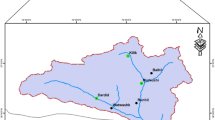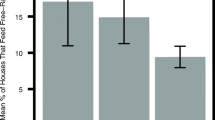Abstract
A questionnaire survey in 48 villages covering over 10,000 km2 in Arunachal Pradesh, India, was conducted to quantify the livestock depredation and resultant killing of dholes in retaliation. Depredation was reported to be caused highest by dhole (Cuon alpinus) in comparison to tiger (Panthera tigris) and leopard (Panthera pardus). Respondents claimed major losses (7.90 %) of socio-culturally valued livestock, i.e., mithun (Bos frontalis), to depredation. Scat analysis revealed livestock constituted only 10 % of the diet of dhole, tiger and leopard. Mithun depredation by dhole was correlated with hunting (r = 0.54, P < 0.01) and retaliatory killing (r = 0.54, P < 0.01). DFA showed retaliatory killing of dhole occurred in areas where depredation was otherwise also reported by other large carnivore. Majority of the respondents welcomed decline in dhole encounters (70.77 %). Prejudices against dhole that correspond to their direct killing in retaliation may lead to unrecoverable losses in its population. This study highlights the significance of the region in securing the long-term survival of large carnivores, especially dholes, in this region.



Similar content being viewed by others
References
Ackerman BB, Lindzey FG, Hemker TP (1984) Cougar food habits in southern Utah. J Wildl Manage 48:147–155
Aiyadurai A, Varma S (2003) Dog and bull – an investigation into carnivore–human conflict in and around Itanagar Wildlife Sanctuary, Arunachal Pradesh. Wildlife Trust of India, New Delhi
Arunachalam A, Pandey HN (2003) Ecosystem restoration of Jhum fallows in Northeast India: microbial C and N along altitudinal and successional gradients. Restor Ecol 11(2):168–173
Babu VN, Venkataraman A (2001) Dhole depredation and its consequences for the carnivore community in Arunachal Pradesh, Northeast India
Beschta R, Ripple W (2009) Large predators and trophic cascades in terrestrial ecosystems of the western United States. Biol Conserv 142(11):2401–2414
Borah J, Deka K, Dookia S, Prasad Gupta R (2009) Food habits of dholes (Cuon alpinus) in Satpura Tiger Reserve, Madhya Pradesh, India. Mammalia 73:85–88
Cohen JA, Fox MW, Johnsingh AJT, Barnett BD (1978) Food habits of the dhole in South India. J Wildl Manage 42:933–936
Dickman AJ, Macdonald EA, Macdonald DW (2011) A review of financial instruments to pay for predator conservation and encourage human–carnivore coexistence. Proc Natl Acad Sci 108:13937–13944
Durbin L, Hedges S, Duckworth J, Tyson M, Iyengar A, Venkataraman A (2008) Cuon alpinus. IUCN
Floyd TJ, Mech LD, Jordan PA (1978) Relating wolf scat content to prey consumed. J Wildl Manage :528–532.
Gopi GV, Lyngdoh S, Selvan KM (2010) Conserving the endangered Asiatic wild dog Cuon alpinus in western Arunachal Pradesh: fostering better coexistence for conservation. Final Technical Report to Rufford Small Grant Programme, London, U.K
Gopi GV, Habib B, Selvan KM, Lyngdoh S (2012) Conservation of the endangered Asiatic wild dog (Cuon alpinus) in Western Arunachal Pradesh: linking ecology, ethnics and economics to foster better coexistence. Wildlife Institute of India, Dehradun DST Project Completion Report DST Project Completeion Report TR-2012:137 pp
Iyengar A, Babu V, Hedges S, Venkataraman A, Maclean N, Morin PA (2005) Phylogeography, genetic structure, and diversity in the dhole (Cuon alpinus). Mol Ecol 14:2281–2297
Jhala Y, Gopal R, Qureshi Q (2008) Status of tigers, co-predators, and prey in India. National Tiger Conservation Authority, Ministry of Environment and Forests, and Wildlife Institue of India, Dehradun
Johnsingh A (1982) Reproduction and social behaviour of the dhole, Cuon alpinus (Canidae). J Zool 198:443–463
Johnson DH (1980) The comparison of usage and availability measurements for evaluating resource preference. Ecology 61:65–71
Karanth KU, Sunquist ME (1995) Prey selection by tiger, leopard and dhole in tropical forests. J Anim Ecol :439–450
Karanth KU, Sunquist ME (2000) Behavioural correlates of predation by tiger (Panthera tigris), leopard (Panthera pardus) and dhole (Cuon alpinus) in Nagarahole. India J Zool 250:255–265
Karanth KU, Nichols JD, Hines JE, Christensen NL Jr (2010) The shrinking ark: patterns of large mammal extinctions in India. Proc R Soc B Biol Sci 277:1971–1979
Kellert SR (1985) Public perceptions of predators, particularly the wolf and coyote. Biol Conserv 31:167–189
Kellert SR, Black M, Rush CR, Bath AJ (1996) Human culture and large carnivore conservation in North America. Conserv Biol 10:977–990
Kissui BM (2008) Livestock predation by lions, leopards, spotted hyenas, and their vulnerability to retaliatory killing in the Maasai steppe, Tanzania. Anim Conserv 11:422–432
Lyngdoh S, Shrotriya S, Goyal SP, Clements H, Hayward MW, Habib B (2014) Prey Preferences of the snow leopard (Panthera uncia): regional diet specificity holds global significance for conservation. PLoS ONE 9(2):1–11
Macdonald DW, Sillero-Zubiri C (2002) Large carnivores and conflict: lion conservation in context. Workshop 2:1–8.
Milner-Gulland EJ, Bennett EL (2003) Wild meat: the bigger picture. Trends Ecol Evol 18:351–357
Mukherjee S, Goyal SP, Chellam R (1994) Standardisation of scat analysis techniques for leopard (Panthera pardus) in Gir National Park, Western India. Mammalia 58(1):139–143
Ogra M, Badola R (2008) Compensating human–wildlife conflict in protected area communities: ground-level perspectives from Uttarakhand, India. Hum Ecol 36:717–729
Oli MK, Taylor IR, Rogers ME (1994) Snow leopard Panthera uncia predation of livestock: an assessment of local perceptions in the Annapurna Conservation Area, Nepal. Biol Conserv 68:63–68
Pianka ER (1973) The structure of lizard communities. Annu Rev Ecol Syst 4:53–74
Ramakrishnan PS, Toky OP (1981) Soil nutrient status of hill agro-ecosystems and recovery pattern after slash and burn agriculture (jhum) in north-eastern India. Plant and Soil, 60(1):41–64
Rangarajan M (2006) India's wildlife history. Orient Blackswan, 135 pp
Rasmussen G (1999) Livestock predation by the painted hunting dog Lycaon pictus in a cattle ranching region of Zimbabwe: a case study. Biol Conserv 88:133–139
Ripple WJ, Beschta RL (2012) Trophic cascades in Yellowstone: the first 15 years after wolf reintroduction. Biol Conserv 145(1):205–213
Robinson JG, Bennett EL (2000) Carrying capacity limits to sustainable hunting in tropical forests. In: Hunting for sustainability in tropical forests, Environment Department Papers. Biodiversity Series. Impact Studies Paper-World Bank (EUA), 76:13–30
Selvan KM, Gopi GV, Lyngdoh S, Habib B (2013) Prey selection and food habits of three sympatric large carnivores in a tropical lowland forest of the Eastern Himalayan Biodiversity Hotspot. Mamm Biol Zeitschr Säugetierkunde 78:296–303
Sillero-Zubiri C, Sukumar R, Treves A (2007) Living with wildlife: the roots of conflict and the solutions. Key topics in conservation biology. Blackwell Publishing, Oxford, pp 253–270
Squires JR, Decesare NJ, Hebblewhite M, Berger J (2012) Missing lynx and trophic cascades in food webs: a reply to Ripple et al. Wildl Soc Bull 36:567–571
Suryawanshi KR, Bhatnagar YV, Redpath S, Mishra C (2013) People, predators and perceptions: patterns of livestock depredation by snow leopards and wolves (ed N Pettorelli). J Appl Ecol 1–11
Treves A (2009) The human dimensions of conflicts with wildlife around protected areas. Wildlife and society: the science of human dimensions. Island Press, Washington, DC, pp 214–228
Treves A, Karanth KU (2003) Human–carnivore conflict and perspectives on carnivore management worldwide. Conserv Biol 17:1491–1499
Varma S, Aiyadurai A, Babu N, Menon V (2010) Patterns and causes of predator–human conflict in and around Itanagar Wildlife Sanctuary, Arunachal Pradesh, Northeastern India. Int J Ecol Environ Sci 36:133–145
Venkataraman AB, Arumugam R, Sukumar R (1995) The foraging ecology of dhole (Cuon alpinus) in Mudumalai Sanctuary, southern India. J Zool 237:543–561
Wang SW, Curtis PD, Lassoie JP (2006) Farmer perceptions of crop damage by wildlife in Jigme Singye Wangchuck National Park, Bhutan. Wildl Soc Bull 34:359–365
Woodroffe R, Ginsberg JR (1998) Edge effects and the extinction of populations inside protected areas. Science 280(5372):2126–2128
Acknowledgements
We thank Dr. V.B. Mathur, Director of the Wildlife Institute of India (WII) and Dr. P.K. Mathur, Dean of the Faculty of Wildlife Sciences of WII, for providing us with the encouragement and logistic support at the Institute. We sincerely thank the Department of Science and Technology, Government of India and the Rufford Small Grant Foundation for providing the necessary fund support. We sincerely thank Drs. A.J.T. Johnsingh, S.K. Dutta, Bhaskar Acharya and Claudio Sillero-Zubiri for their support. Most of all, we earnestly acknowledge the Department of Environment and Forest, Government of Arunachal Pradesh, particularly Mr. J.L. Singh, C. Loma, P. Ringu, and Tana Tapi. We are grateful to our field assistants, Rubu Tagio, Joli Weli and Gangaram Chiri, for their immense support in data collection.
Author information
Authors and Affiliations
Corresponding author
Additional information
Communicated by R. White
Rights and permissions
About this article
Cite this article
Lyngdoh, S., Gopi, G.V., Selvan, K.M. et al. Effect of interactions among ethnic communities, livestock and wild dogs (Cuon alpinus) in Arunachal Pradesh, India. Eur J Wildl Res 60, 771–780 (2014). https://doi.org/10.1007/s10344-014-0846-8
Received:
Revised:
Accepted:
Published:
Issue Date:
DOI: https://doi.org/10.1007/s10344-014-0846-8




